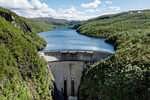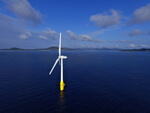07/07/2011
Special Report - Replicating Nature for the benefit of technological progress
Looking to Nature for the benefit of technological progress, i.e. replicating the way nature provides elegant solutions to seemingly impossible problems, has been a course of action for generations of scientists - the most famous being the Wright Brothers who looked to the wings of birds and how they fly to ultimately provide mankind with the means of flight.
In the wind energy sector, this has been true for many new inventions and the optimisation of wind turbines. Now, the jellyfish is providing impetus for new developments in various renewable energy sectors.
"Jellyfish have always been the highlight of aquarium visits – their easy grace moving through the water is something to be desired. Bioengineering professor John Dabiri is just as fascinated with the sea creature, but his interest goes far beyond their natural beauty. Dabiri’s fluid dynamics laboratory at the California Institute of Technology is exploring the mechanics and dynamics of biological propulsion through the jellyfish’s simple morphology and complex patterns of motion. With this research the professor hopes to develop more efficient engineered systems of propulsion, as well as energy technologies that could harness wind and wave power.
The moon jellyfish is one of the oldest and simplest mechanisms of biological propulsion, but their simple forms actually make them an ideal system for research. One of the earliest observational findings of Dabiri’s lab is that these jellyfish do not move through water using simple jet propulsion, instead, they propel themselves forward by creating complex vortex rings in the wake of their motion which then enable them to push off and gather more momentum.
The lab’s research on exactly how jellyfish form these currents and the resulting fluid dynamics has the potential to inform not only our understanding of biological systems, but also the development of a more efficient propulsion model. The future of their work could be as widespread as underwater transportation or medical technologies administered through the bloodstream, but may not even be limited to liquid applications!
Another area of interest is the motivation behind schooling in fish; the hypothesis being that the regular patterns of group motion actually lower the energy cost of each individual fish. Their encouraging findings have the strongest implications for alternatives to large and unsightly turbines in energy technology, introducing the possibility that smaller, grouped structures might be more efficient in harnessing wind power.
Whether though wind or wave motion, Dabiri’s lab is looking at ways to manipulate sources of power for maximum gain and efficiency. His research aims at taking advantage of biological solutions that have existed for centuries to the issues that our engineers are currently facing in energy technologies. The twist is that their approach is to analyze the dynamics of the material, to understand its patterns on a very elementary level and ultimately to work with the fluid in the same way that nature does.
He is already talking about the implications that his research could have for engineering systems and new technologies, and people are certainly listening. Dabiri has been named to the “Brilliant 10” young scientists in Popular Science magazine, and, in the past year, he was the recipient of a 2010 MacArthur Fellowship and promoted to a tenured professor at Caltech. And at the remarkably young age of 30, he is only just beginning his contribution to biologically inspired design!"
So, we at the Windfair.net community look very much forward to hearing a lot from Prof. Dibri for the wind energy sector in the future!
Please follow the following links (copy & paste URL into browser) for further examples of replicating Nature to optimise wind terbines:
- Humpback whales inspire new wind turbine technology: The unique design of their flippers enable a steeper operating angle of the blade—and a 40% performance increase - WhalePower - "Building the Energy on a Million Years of Field Tests"
http://www.whalepower.com/drupal/?q=node/1
http://challenge.ecomagination.com/ideas/WinDNA-Vertical-axis-wind-turbine-inspir
- The project is a demonstration of how active trailing edge flaps on wind turbine blades can stabilise the rotor so the loads are reduced - Vestas
http://hoejteknologifonden.dk/en/project_gallery/project_gallery/wind_turbines_inspired_by_nature/
- The project group aims to develop a flexible flap for continuous wind turbine blade adaptation under turbulent wind conditions. Special wind detector sensors send data to a computer which calculates flap position. This reduces turbine weight as well as production costs - Vestas
http://www.treehugger.com/files/2009/11/flapping-wind-turbine-inspired-by-bumble-bee-wings.php
- Green Wavelength, an up-and-coming California engineering biz, has prototyped a small wind turbine, the xBEE, the elegant flapping motion of which is inspired by the buzz of insect wings such as bees
http://www.greenwavelength.com/products/
There are a multitude of new innovative developments and technological breakthroughs being attributed to Nature.
For more information on this article or if you would like to know more about what www.windfair.net can offer, please do not hesitate to contact Trevor Sievert at ts@windfair.net
www.windfair.net is the largest international B2B Internet platform – ultimately designed for connecting wind energy enthusiasts and companies across the globe!
In the wind energy sector, this has been true for many new inventions and the optimisation of wind turbines. Now, the jellyfish is providing impetus for new developments in various renewable energy sectors.
"Jellyfish have always been the highlight of aquarium visits – their easy grace moving through the water is something to be desired. Bioengineering professor John Dabiri is just as fascinated with the sea creature, but his interest goes far beyond their natural beauty. Dabiri’s fluid dynamics laboratory at the California Institute of Technology is exploring the mechanics and dynamics of biological propulsion through the jellyfish’s simple morphology and complex patterns of motion. With this research the professor hopes to develop more efficient engineered systems of propulsion, as well as energy technologies that could harness wind and wave power.
The moon jellyfish is one of the oldest and simplest mechanisms of biological propulsion, but their simple forms actually make them an ideal system for research. One of the earliest observational findings of Dabiri’s lab is that these jellyfish do not move through water using simple jet propulsion, instead, they propel themselves forward by creating complex vortex rings in the wake of their motion which then enable them to push off and gather more momentum.
The lab’s research on exactly how jellyfish form these currents and the resulting fluid dynamics has the potential to inform not only our understanding of biological systems, but also the development of a more efficient propulsion model. The future of their work could be as widespread as underwater transportation or medical technologies administered through the bloodstream, but may not even be limited to liquid applications!
Another area of interest is the motivation behind schooling in fish; the hypothesis being that the regular patterns of group motion actually lower the energy cost of each individual fish. Their encouraging findings have the strongest implications for alternatives to large and unsightly turbines in energy technology, introducing the possibility that smaller, grouped structures might be more efficient in harnessing wind power.
Whether though wind or wave motion, Dabiri’s lab is looking at ways to manipulate sources of power for maximum gain and efficiency. His research aims at taking advantage of biological solutions that have existed for centuries to the issues that our engineers are currently facing in energy technologies. The twist is that their approach is to analyze the dynamics of the material, to understand its patterns on a very elementary level and ultimately to work with the fluid in the same way that nature does.
He is already talking about the implications that his research could have for engineering systems and new technologies, and people are certainly listening. Dabiri has been named to the “Brilliant 10” young scientists in Popular Science magazine, and, in the past year, he was the recipient of a 2010 MacArthur Fellowship and promoted to a tenured professor at Caltech. And at the remarkably young age of 30, he is only just beginning his contribution to biologically inspired design!"
So, we at the Windfair.net community look very much forward to hearing a lot from Prof. Dibri for the wind energy sector in the future!
Please follow the following links (copy & paste URL into browser) for further examples of replicating Nature to optimise wind terbines:
- Humpback whales inspire new wind turbine technology: The unique design of their flippers enable a steeper operating angle of the blade—and a 40% performance increase - WhalePower - "Building the Energy on a Million Years of Field Tests"
http://www.whalepower.com/drupal/?q=node/1
http://challenge.ecomagination.com/ideas/WinDNA-Vertical-axis-wind-turbine-inspir
- The project is a demonstration of how active trailing edge flaps on wind turbine blades can stabilise the rotor so the loads are reduced - Vestas
http://hoejteknologifonden.dk/en/project_gallery/project_gallery/wind_turbines_inspired_by_nature/
- The project group aims to develop a flexible flap for continuous wind turbine blade adaptation under turbulent wind conditions. Special wind detector sensors send data to a computer which calculates flap position. This reduces turbine weight as well as production costs - Vestas
http://www.treehugger.com/files/2009/11/flapping-wind-turbine-inspired-by-bumble-bee-wings.php
- Green Wavelength, an up-and-coming California engineering biz, has prototyped a small wind turbine, the xBEE, the elegant flapping motion of which is inspired by the buzz of insect wings such as bees
http://www.greenwavelength.com/products/
There are a multitude of new innovative developments and technological breakthroughs being attributed to Nature.
For more information on this article or if you would like to know more about what www.windfair.net can offer, please do not hesitate to contact Trevor Sievert at ts@windfair.net
www.windfair.net is the largest international B2B Internet platform – ultimately designed for connecting wind energy enthusiasts and companies across the globe!
- Source:
- Online Editorial www.windfair.net
- Author:
- Posted by Trevor Sievert, Online Editorial Journalist / Photo: Mike Baird - www.flickr.com
- Email:
- ts@windfair.net
- Link:
- www.windfair.net/...
- Keywords:
- wind, wind energy, wind turbine, rotorblade, awea, ewea, wind power, suppliers, manufacturerstrevor sievert






